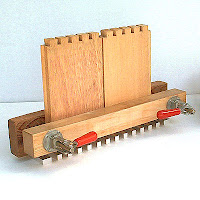Accurate jointing or chamfering this requires that the cutter head blades be adjusted precisely with reference to the out feed table. The edge of each cutter head blade must exactly at the level of the out feed table: not above or below it. In most cases, sharpening the cutter blades requires that they be removed completely from the cutter head and then replaced and adjusted after sharpening. This is why I recommend the use of solid carbide as opposed to high speed steel blades: Carbide blades last a lot longer and that means less time and effort has to go into removing, replacing and adjusting blades. Buy two sets. That way, you can continue to use your jointer while the dull set is out for sharpening and you will always have a sharp set waiting.
Always unplug your jointer from electrical current before attempting any blade adjustments. In my jointer, an 8” Rockwell/Delta classic, the blades are removed and replaced by using a flat wrench that came with the jointer. This wrench is used to loosen and tighten the hex head machine screws that press against the blades and hold them in place in the cutter head. It is very easy to round over the hex heads, so I am very careful not to do so. I purchased a gadget that helps me align the blades with reference to the out feed table. It magnetically attaches itself to the surface of the out feed table and magnetically attracts the blades upwards and holds them in position while I tighten the hex bolts. Each blade (there are 3 in my machine) must be in the extreme vertical position before it can be individually correctly adjusted and tightened. When all 3 blades have been set properly, they should just touch, but not lift, a flat piece of wood laid on the out feed table, extending over the cutter head. They must do this across their entire length of each blade.
In a tool review at http://www.perfectwoodworking.com, I take a look at several jointers of different sizes from different manufacturers which may help you select a new jointer that's just right for you and your shop. This post was excerpted from the beginning of that series of reviews.
Jointer size is most commonly determined by the full width of the blades (knives). A 6” jointer makes a maximum 6”-wide cut. An 8” jointer makes a maximum 8” cut and so on. It would be rare to use the entire width of even a 6” knife set at once, so the real advantage of wide knives is that you can move the fence to use a shaper place on the knife when the knife becomes dull. The wider your blades, the more use you will get out of them before it is time to re-sharpen. I usually start with a sharp blade and the fence all the way to the right end of the cutter head and move the fence, in increments, a bit wider than the maximum board thicknesses, to the left until the blades are all used up.
Sometimes, with curly or wavy grain structure, you will experience tear-out from the lumber edge even with sharp knives. Sometimes you can turn the board around and run it through again backwards with very shallow cuts until the edge is fully jointed and the tear-out is gone. At other times, you may have to settle for a sawn joint made on the table saw. Usually you can make fairly good glue joints this way, if you have to, but a jointed edge is always my first choice.
The depth of cut is determined by the height of the in feed table with reference to the out feed table. The lower the in feed table, the more wood is removed with each pass over the jointer. It is not a good idea to take off too much wood with a single pass. The chances of tear-out increase with the depth of cut and you may end up removing more precious wood than you really needed to, to get your perfect joint.
In the jointer reviews at http://www.perfectwoodworking.com/jointerreviews, I work from the smallest up to the largest and the least expensive up to the most expensive. Those reviews include the Delta 6" Variable Speed Bench Jointer, the Jet JJ-6CS 6" Closed Stand Jointer, the Jet JJ-8CS 8" Closed Stand Jointer, the Powermatic 8" Parallelogram Jointer, the Laguna Tools 12" Industrial Jointer and the Powermatic 16" Parallelogram Jointer.
Bob Gillespie
Woodworker
For Similar Articles and Tool Reviews see:
http://www.perfectwoodworking.com










